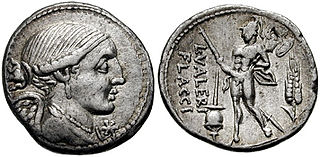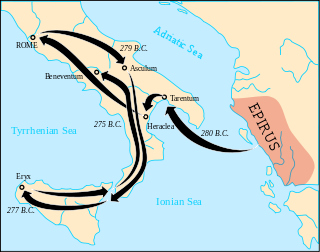Related Research Articles

The First Punic War was the first of three wars fought between Rome and Carthage, the two main powers of the western Mediterranean in the early 3rd century BC. For 23 years, in the longest continuous conflict and greatest naval war of antiquity, the two powers struggled for supremacy. The war was fought primarily on the Mediterranean island of Sicily and its surrounding waters, and also in North Africa. After immense losses on both sides, the Carthaginians were defeated.
This article concerns the period 219 BC – 210 BC.

The gens Valeria was a patrician family at ancient Rome, prominent from the very beginning of the Republic to the latest period of the Empire. Publius Valerius Poplicola was one of the consuls in 509 BC, the year that saw the overthrow of the Tarquins, and the members of his family were among the most celebrated statesmen and generals at the beginning of the Republic. Over the next ten centuries, few gentes produced as many distinguished men, and at every period the name of Valerius was constantly to be found in the lists of annual magistrates, and held in the highest honour. Several of the emperors claimed descent from the Valerii, whose name they bore as part of their official nomenclature.
Quintus Baebius Tamphilus was a praetor of the Roman Republic who participated in negotiations with Hannibal attempting to forestall the Second Punic War.
The gens Fulvia, originally Foulvia, was one of the most illustrious plebeian families at ancient Rome. Members of this gens first came to prominence during the middle Republic; the first to attain the consulship was Lucius Fulvius Curvus in 322 BC. From that time, the Fulvii were active in the politics of the Roman state, and gained a reputation for excellent military leaders.

The Battle of Cape Ecnomus or Eknomos was a naval battle, fought off southern Sicily, in 256 BC, between the fleets of Carthage and the Roman Republic, during the First Punic War. It was the largest battle of the war and one of the largest naval battles in history. The Carthaginian fleet was commanded by Hanno and Hamilcar; the Roman fleet jointly by the consuls for the year, Marcus Atilius Regulus and Lucius Manlius Vulso Longus. It resulted in a clear victory for the Romans.
Gnaeus Cornelius Scipio Asina was a Roman general and statesman who fought in the First Punic War.

The Pyrrhic War was largely fought between the Roman Republic and Pyrrhus, the king of Epirus, who had been asked by the people of the Greek city of Tarentum in southern Italy to help them in their war against the Romans.
The Battle of Panormus was fought in Sicily in 250 BC during the First Punic War between a Roman army led by Lucius Caecilius Metellus and a Carthaginian force led by Hasdrubal, son of Hanno. The Roman force of two Roman and two allied legions defending the city of Panormus defeated the much larger Carthaginian army of 30,000 men and between 60 and 142 war elephants.

Sicilia was the first province acquired by the Roman Republic, encompassing the island of Sicily. The western part of the island was brought under Roman control in 241 BC at the conclusion of the First Punic War with Carthage. A praetor was regularly assigned to the island from c.227 BC. The Kingdom of Syracuse under Hieron II remained an independent ally of Rome until its defeat in 212 BC during the Second Punic War. Thereafter the province included the whole of the island of Sicily, the island of Malta, and the smaller island groups.
Marcus Valerius Laevinus was a Roman consul and commander who rose to prominence during the Second Punic War and corresponding First Macedonian War. A member of the gens Valeria, an old patrician family believed to have migrated to Rome under the Sabine king T. Tatius, Laevinus played an integral role in the containment of the Macedonian threat.
The Treaty of Lutatius was the agreement between Carthage and Rome of 241 BC, that ended the First Punic War after 23 years of conflict. Most of the fighting during the war took place on, or in the waters around, the island of Sicily and in 241 BC a Carthaginian fleet was defeated by a Roman fleet commanded by Gaius Lutatius Catulus while attempting to lift the blockade of its last, beleaguered, strongholds there. Accepting defeat, the Carthaginian Senate ordered their army commander on Sicily, Hamilcar Barca, to negotiate a peace treaty with the Romans, on whatever terms he could negotiate. Hamilcar refused, claiming the surrender was unnecessary, and the negotiation of the peace terms was left to Gisco, the commander of Lilybaeum, as the next most senior Carthaginian on the island. A draft treaty was rapidly agreed, but when it was referred to Rome for ratification it was rejected.
Gaius Atilius Regulus was a Roman Republican consul who twice held the consulship in the middle of the 3rd century BC. He seems not to be closely related to M. Atilius M.f L.n. Regulus, for the grandfather of Regulus Serranus was named Marcus. Most likely the grandfathers were brothers and the successive consuls of 257 and 256 were second cousins.
The gens Otacilia, originally Octacilia, was a plebeian family at ancient Rome. The gens first rose to prominence during the First Punic War, but afterwards lapsed into obscurity. The first of the family to obtain the consulship was Manius Otacilius Crassus, in 263 BC.
Lucius Valerius Flaccus was a Roman politician and general. He was consul in 195 BC and censor in 183 BC, serving both times with his friend Cato the Elder, whom he brought to the notice of the Roman political elite.
The siege of Lilybaeum lasted for nine years, from 250 to 241 BC, as the Roman army laid siege to the Carthaginian-held Sicilian city of Lilybaeum during the First Punic War. Rome and Carthage had been at war since 264 BC, fighting mostly on the island of Sicily or in the waters around it, and the Romans were slowly pushing the Carthaginians back. By 250 BC, the Carthaginians held only the cities of Lilybaeum and Drepana; these were well-fortified and situated on the west coast, where they could be supplied and reinforced by sea without the Romans being able to use their superior army to interfere.
Lucius Junius Pullus was a politician and general of the Roman Republic. He was consul in 249 BCE together with Publius Claudius Pulcher. He and his consular coleague fought in the ongoing First Punic War.
Titus Otacilius Crassus was a Roman statesman and general during the middle era of the Roman Republic. He was one of the two consuls of 261 BCE, serving with Lucius Valerius Flaccus. During his consulship, he and his consular colleague Flaccus fought against the Carthaginians on Sicily as part of the ongoing First Punic War. Before sailing to Sicily they strengthened the coastal defences of Italy against attacks by Hannibal Gisco, a Carthaginian admiral sent to raid the Tyrrhenian coast. The consuls besieged Mytistraton, but were eventually driven off by Hamilcar, the new commander of Carthage's Sicilian army, who defeated them at Thermae near Palermo. They returned to Italy were they started building Rome's first warfleet, created after Carthaginian example. In 260, the fleet was ready and would be used by Gnaeus Cornelius Scipio Asina, one of the two consuls of that year.
The naval Battle of Phintias took place in 249 BC during the First Punic War near modern Licata, southern Sicily between the fleets of Carthage under Carthalo and the Roman Republic under Lucius Junius Pullus. The Carthaginian fleet had intercepted the Roman Fleet off Phintias, and had forced it to seek shelter. Carthalo, who heeded the warning of his pilots about impending storms, retired to the east to avoid the coming weather. The Roman fleet did not take any precautions and subsequently was destroyed with the loss of all but two ships. The Carthaginians exploited their victory by raiding the coasts of Roman Italy until 243 BC. The Romans did not mount a major naval effort until 242 BC.
Marcus Aemilius Paullus was a Roman statesman and general during the middle era of the Roman Republic. He was one of the consuls of 255 BCE, serving with Servius Fulvius Paetinius Nobilior. As consul Paullus led the Republic's forces in the ongoing First Punic War against Carthage; he and Paetinus led a Roman fleet of 350 warships to Africa to rescue the remnants of the army of proconsul Marcus Atilius Regelus, who had been defeated in the Battle of the Bagradas River earlier that year. Onroute they defeated a Carthaginian fleet of 200 warships in the Battle of Cape Hermaeum.
References
- ↑ Polybius 1.20.3–7, cf. Diodorus Siculus 23.9; Frontinus, Stratagems 3.16.3; Zonaras 8.10, as cited by T.R.S. Broughton, The Magistrates of the Roman Republic (American Philological Association, 1951, 1986), vol. 1, p. 204.
- ↑ Polybius 1.20-21
- ↑ A Lucius Valerius Flaccus had been magister equitum in 321 BC (Livy 8.18.13), but nothing else is known of the man.